|
FAQs about Sea Mats, Star Polyps Identification
2
Related Articles: Mat/Star Polyps, Blue, Pipe Organ Corals,
Related FAQs: Polyp/Clavulariid Identification, Polyp/Clavulariid ID 3, Polyp/Clavulariid ID 4, & Polyps 1, Polyps 2, Polyps 3, Polyp Behavior, Polyp Compatibility, Polyp Selection, Polyp Systems, Polyp Feeding, Polyp Disease, Polyp Reproduction/Propagation,
|
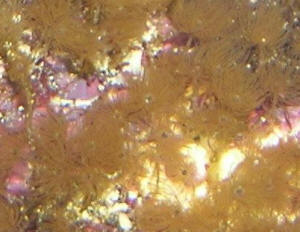
|
|
Coral ID 3/9/09 Hello, <Hi Kai> I do
not have a question today, would just like to know if you could
help me ID this? I got it at my LFS a few days ago and they told
me it was Xenia. However, when I brought it home and after it
started opening up, it looked more like Anthelia than Xenia to
me. They seem to be pulsing very weakly... What is your opinion
on this? I have a friend who is interested in a frag of this, and
I feel that I should let him know exactly what it is before I
decide to give it to him. I have read the FAQ on WetWebMedia
regarding Xenias, and remember reading that Anthelias grow on
mats? Whilst Xenia grow on stalks? The coral I have seem to have
a little bit of both...short stalks with 1-2 polyps and they are
all connected via an encrusting mat. <I'm thinking you are
referring to the background coral rather than the foreground but
actually, both appear to be Clavularia species with the
background coral commonly called Clove Polyps) and the foreground
coral called Glove Polyps.> Thanks and have a good day (:
<You're welcome. James (Salty Dog)> - Kai
|
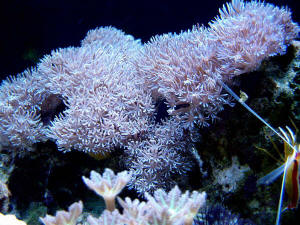 |
|
Unidentified Octocoral 12/10/08 Dear
WWM-Crew, May I ask you to help me identify a hitchhiker
Octocoral (Stoloniferan?)? I have found it 3 days ago on a piece
of live rock that has been in my tank for about a year. The rock
was chiseled into smaller pieces to get a Hydnophora sp. away
from a Montipora digitata that has been eaten almost completely
in the course of one night (I knew that it would happen sooner or
later but was too lazy to act earlier...). On one of the pieces
of the broken rock I saw this coral (slightly blurry photo
attached, please tell me if you need a higher-res version). Its
polyps are between 2 and 3 millimeters in diameter (total size
when expanded, including tentacles - thus the low quality of the
photograph taken with a macro lens), the center is white and the
surrounding tentacles are a violet/brownish color. The polyps are
interconnected by a brown "cord" (not a mat) attached
to the surface of the rock. <Thank you for noting this.> I
have researched quite a bit but couldn't find an exact match
- most Stoloniferans described have larger polyps. I was hoping
that you could help me identify it to family/genus/species level.
<I do think it's likely a Clavularia sp., i.e. "clove
polyps"-- is my best guess.> Thank you in advance &
best wishes from the old world, Alex <De nada and best to you
tambien, Sara M.>
|
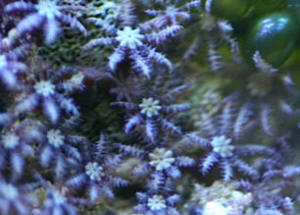 |
Question: Is this a hydroid? 12/5/08
Hello, Wet Web Media Crew I would like to begin by proclaiming my
love for your site. I began to visit this site six months before I
set up my first saltwater tank and have visited it almost daily
since. I use your site to do research on sea creatures that I have
absolutely no intention of ever buying (or even seeing in person,
for that matter) just because you have such a wonderful plethora of
information. <Ahh, most welcome> Anyway, I have recently
found a mystery hitchhiker in my tank. I have searched through all
of the FAQs I could find on your site and have not yet found a
match as to what type of organism this might be. I am concerned
that it is a hydroid of some sort. If this is the case, I want to
get it out of my tank right away. However, if it is something more
innocuous, I would like to leave it be. <I would leave be... is
not a hydroid but some sort of Octocoral... an Anthozoan... note
the eight multiple tentacle pinnate polyps. Please see here:
http://wetwebmedia.com/cnidaria.htm and on the Net in general re
Octocoral identification...> I have attached a photo to this
message. The organism in question appears to consistently have
eight "tentacles," <Ah yes> and all of the
different polyps seem to sprout from a common vein that runs along
the piece of rock the organism is attached to. It also is capable
of retracting, if that makes a difference. <Does... Please see
here: http://www.wetwebmedia.com/polypidfaqs.htm What you have is
some sort of "Star Polyp"... a Clavulariid> Thank you
for all that you do, Megan
<Welcome, and enjoy these. Bob Fenner> |
 |
|
Clove polyps, hydroids or feather dusters-
octagonal ID 11/03/07 Hello Crew, <Good evening, Sara
here.> My tank has been running for three weeks with live rock
that my LFS says came from Bali Indonesia. Several of the pieces
have colonies of polyps growing on them and they seem to be
spreading. I'm hoping you can tell me if these are something
I need to worry about and ultimately remove. At first I thought
they might be Aiptasia but I have ruled that out. <Good
thought, they're not Aiptasia.> I'm now thinking that
these are either clove polyps or some sort of hydroid. <Well,
the fact that they have eight tentacles per polyp is a big hint.
Thus, I would conclude that it is an Octocoral of some sort.>
I guess it is possible they are feather dusters but I doubt that.
<Agreed. Not feather dusters...> Each polyp is brown and
has eight feathery tentacles. <good observation> The
tentacles retract into the stem if they are touched with the
handle of my net. The polyps are less than .25 inches in
diameter. I'm not sure if these will actually sting me so I
haven't touched them with my fingers. Any help with
ID'ing these and letting me know if and how these should be
removed would be greatly appreciated. <They're some kid of
"clove coral." Unfortunately, some hitch-hiking clove
corals can be as much a pain (if not more of a pain) than any
hydroid or Aiptasia. I've battled some that got into my
aquarium for over a year now. I don't know if yours will be
quite as invasive or relentless as mine have been, but if I were
you, I wouldn't take any chances. Unless you really like
them, I'd suggest you try to kill them off now before they
get too settled in. Start with Kalk. If that doesn't work,
try vinegar. If that doesn't work... uh, there's always
NaOH as a last resort (but that's very corrosive stuff, so
try not to mess with it if you don't have to).>
Thanks,
Paul
<De nada,
Sara M.>
|
|
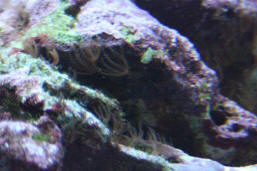 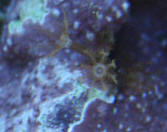
|
|
ID on live rock... Octocoral - 10/18/07
Hello, <Hi John, Mich with you tonight.> I was wondering if
someone could help with an I.D. of life that came on a piece of
live rock I purchased the other day. <Well at quick glance I
thought it was a sponge, but it is not. On closer inspection it
looks like an Octocoral of some sort, perhaps of the family
Clavulariidae. A nice surprise for you.> Picture attached.
Thanks,
<Welcome! Mich>
John
|
|
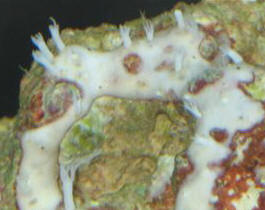
|
|
Polyp ID Please... Pachyclavularia I believe 9/6/07 Dear
WetWebMedia <Mich here, apologizing for the delayed
response.> Your website has been an invaluable source of
information for me in the hobby of fresh and saltwater keeping.
<Glad to hear! Bob will be pleased to read, I'm
sure.><<Ah, yes.>> Recently, I picked up a colony
of "Star Polyps". I live in Japan and that is what the
shop owner said was their name. (Japanese naming conventions tend
to differ from English ones) After doing a search on your site
and the web I am beginning to wonder if what I have are actually
Star Polyps since mine look quite different. <Not typically
looking, but not out of the realm of possibilities. They could
indeed be star polyps. I have been discussing this with a fellow
crewmember and after much debate I do think these are star polyps
(Pachyclavularia). Though I'd be remiss if I failed to
mention Briareum and even Anthelia as other perhaps more
desirable possibilities.> Could you give this pic a once over
to reconfirm that these are indeed Star Polyps. <Well, I
wouldn't want to wager a lot of money on it, but yes.>
Thank you! <Welcome, Mich>
Re: Polyp ID Please... Pachyclavularia I believe
9/7/07 Dear WetWebMedia Crew (Mich) <Hello again, Mich
here.> Thank you for you input. <Welcome!> My wife
bought them on a whim and they are doing fine in the tank. And if
they truly are Star Polyps (Pachyclavularia) they likely will
continue to do fine. They are generally quite hardy and can be
allelopathic to the detriment of others. More here and the
related links in blue:
http://www.wetwebmedia.com/clavulariids.htm > The piece of
rock also came with a lot of goodies as well. <Grab-bag! (R*n
with this hasher over the weekend!)> So I am happy either way.
Thank you again. <Oh good! But do be careful to keep other
corals a good distance away from this polyp patch. Mich>
|
|
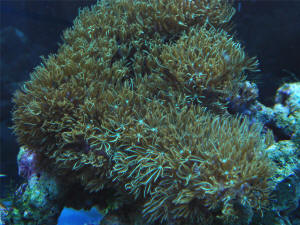
|
Polyp identification 9/2/07 Ok,
question # 2 today. I just purchased some live rock and they have
these two items on them, one is what I believe to be button polyps
in the attached picture (the large ones on the right)
<"Button polyps" or Palythoa/Zoanthids, whatever you
want to call them. They're colonial cnidarians of the Order
Zoanthidea.> what I can't identify through searching the
FAQ's is the pink tipped green anemone looking things on the
right. <It seems that there are a lot of these types of little
anemones which come in as hitchhikers. I've seen them called
"majano" or "tulip" anemones. I don't know
much about their specific taxonomy or even if they're all the
same genus/species. Pretty much all I can tell you with any
certainty is that they're common and tend to be harmless. For
some people they become pests (by going forth to be fruitful and
multiple). However, generally it seems they are less often a
nuisance than are Aiptasia. Personally, I think they're cool
and I actually tried to get them to multiply in my tank without any
success. So, basically it's a gamble. They might become a
nuisance or they might not.> My question is what are these two
species, and what do I do to keep them, I.e.. feeding, lighting?
<You shouldn't have to feed them specifically. If you
generally feed the tank well, they should get what they need. Both
cnidarians like high light but can usually adapt to less light.>
Thanks Dan_
<De nada,
Sara M.> |
|
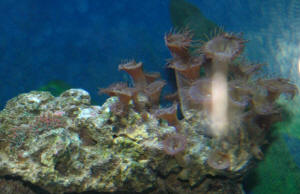 and bonus Anemonia majano at left! RMF. and bonus Anemonia majano at left! RMF.
|
|
Mystery ID: Clavularia - 6/2/07 Hi Crew,
<Hi Kirk> First off I would like to thank you guys and
girls for such a great website. The amount of information is
unbelievable! <Thanks!> My first saltwater tank has been
running for 8 months now and this is the first time that I have
not been able to answer a question by searching the site. Now for
my question. There are creatures that are slowly spreading across
one of the rocks in my tank. I think they are some sort of worm
though I guess they could be a Cnidarian species. <You're
thinking right!> I've attached two pictures of them. The
first shows them closed up at night. The tube-like structures
near the center of the picture are the first parts to expand into
unoccupied territory on the rock. The second picture shows them
open during the day. They kind of look like underwater flowers.
<Indeed. They're very pretty too. Some call these
"Daisy", or "clove" polyps.> The
"flower" on top is 3-4 mm across. They don't seem
to be hurting anything as my Xenia has "walked" onto
this rock without showing any ill effects. I was wondering if you
could help me with the ID at all. <What you have there is a
stoloniferous coral, most likely a Clavulariid of some type. As
you've already noticed, these guys like to spread out so just
keep an eye on them. Lots of information, starting here:
http://www.wetwebmedia.com/clavulariids.htm > Thanks a
lot,
Kirk
<You're very welcome. -Lynn>
|
|
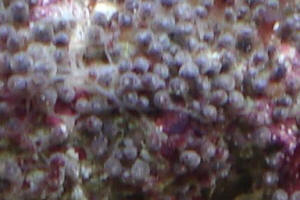 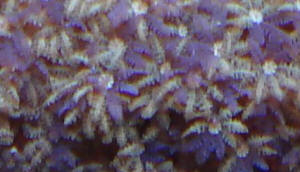
|
| Please identify 9/25/06 Hi
<Howdy> I am not sure what this is. It came on the base of an
Acropora coral and has since spread rapidly. It looks kind of like
a flower growing on a vine. It spreads by sending out a runner and
then shoots come from the runner. <Yep> Any idea what it is?
How can I get rid of it? I have looked all through your site and
through all the books I can find. Hope you can help. Mike <Is a
Zoanthid or Clavulariid Polyp of some sort... Please read here:
http://www.wetwebmedia.com/zoanthid.htm and the linked
files above... Compatibility re removal... BobF> |
|

|
|
|

